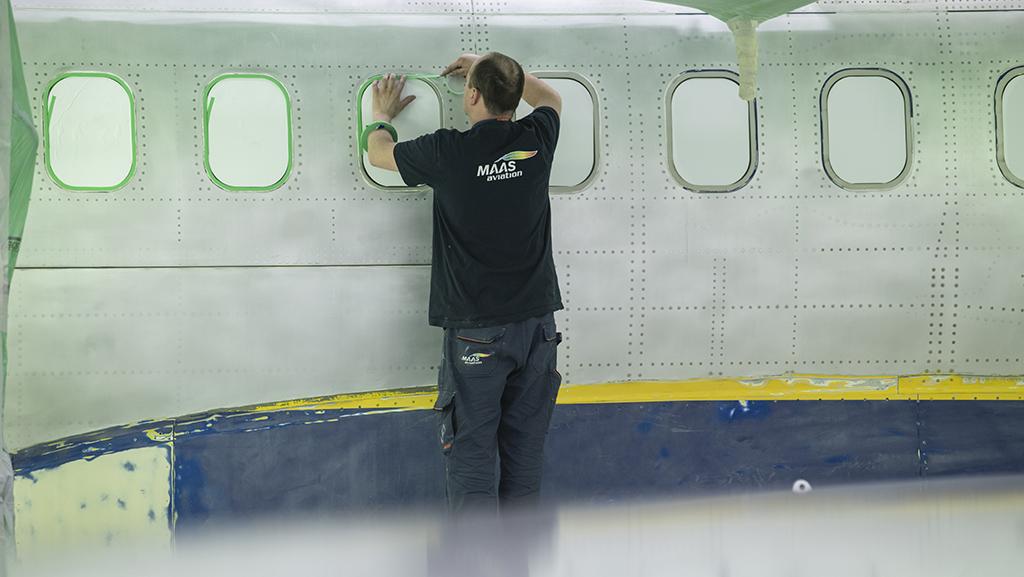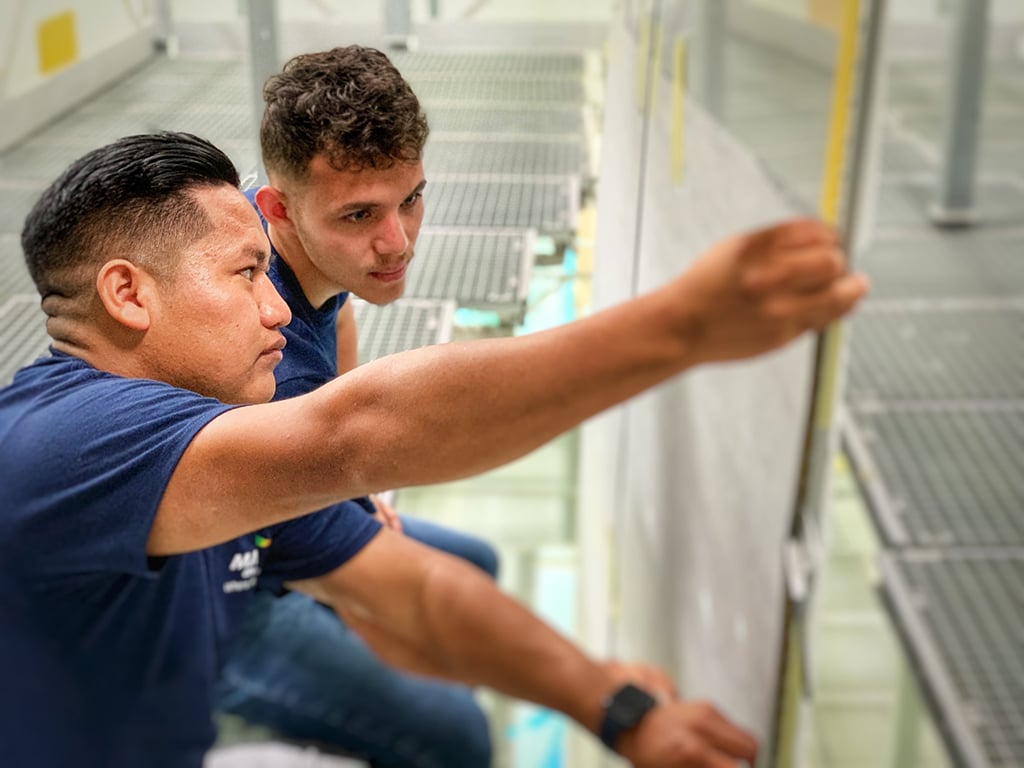
MAAS Aviation’s paint shops have aligned training programs that combine practical and theoretical training.
The supposed lack of standardized qualifications for aircraft painters has become an issue—it appears that there are no specific standards for paint technicians or painting service providers in the aviation industry. The good news is that regulators are confident that specialist painting suppliers already follow stringent standards of their own.
In the UK, the Aircraft Painter Certification Scheme (APCS) is an independent set of standards that runs in accordance with ISO 17024–General Requirements for Bodies Operating Certification of Persons. APCS addresses concerns about the use of what it calls unregulated aircraft painters in aircraft maintenance. The scheme also provides a regulated framework for aircraft painters to establish their competence to work safely in, on and around aircraft.
“This is essential in an industry where we believe it is important to be able to verify a safe and efficient level of competence of persons prior to them being allowed to work on aircraft,” says Richard Green, course director at APCS.
APCS has found that there are an increasing number of aircraft painters either lacking in basic painting skills or who have the necessary skills but lack the essential knowledge of the hazard implications around aircraft and their components. Green suggests that this has led to accidents and costly problems, delays and damage.
Rihards Priedkalns, painting department manager at Estonia-based Magnetic Group, concurs. “There is a lack of qualification programs and there is no regulation for aircraft painter positions from regulatory bodies, and this should be addressed,” he says. As for training, Priedkalns says that suitable schools exist—but they follow their own programs and the certificates they confer are not globally recognized due to the lack of standardized rules.
“During the last few years, it has come to our attention that more inexperienced staff (especially contractors) have started working in the aircraft painting field,” he says. Priedkalns says this is due to the acute shortage of qualified personnel, combined with relatively low skill requirements for paint shop workers.
Without a recognized aircraft-specific painting course, APCS maintains that anyone can claim to be an aircraft painter, and that this has led to inexperienced painters and preppers working on aircraft. “We also feel most aircraft owners, given the choice, would want to know their asset has been prepped and finished by personnel that have demonstrated a basic level of competency,” Green adds.

Richard Marston, chief commercial officer at MAAS Aviation, asserts that any established, accredited training program that supports and promotes staff entering and remaining in the aircraft painting industry can only be a positive step forward. “It is well reported that all industries have faced challenges attracting and retaining staff post-COVID, and the aircraft painting sector has been particularly impacted,” he says. “This is in part due to the technical and safety aspects associated with the painting process, but also because painting planes is really hard work.”
Marston hears the increasing calls to set standards for aircraft painting technicians for various reasons and contends that the key is for airlines, MROs and OEMs to make sure they are working with experienced aircraft painting organizations with a solid track record and reputation, as well as developing comprehensive training modules focused on safe working practices that protect staff and the aircraft they work on.
Aircraft painting is a specialized skill, and at Ireland-based International Aerospace Coatings (IAC) , all new employees across its 11 global locations undergo a 12-week training course that equips them with the skills required to strip aircraft of existing finishes, prepare them for refinishing and then properly apply aircraft paint by hand and spray gun.
IAC also runs an apprenticeship training program with City & Guilds in conjunction with local enterprise boards. Upon successful completion of the course, graduates are awarded a Level 3 National Vocational Qualification diploma in Aeronautical Engineering (Aircraft Surface Finishing). “This is a globally recognized qualification,” says John Mulqueen, vice president of operations for Europe at IAC.
As Mulqueen explains, the program is further supported by several external paint companies such as AkzoNobel and PPG. “Our current staff model reflects that over half of our team leaders in our Shannon, [Ireland,] paint operation started their career with this training program,” he says. “This is a testament and a hugely positive reflection as to the success of this training program. IAC also has an internal development program with high standards and competency levels.”
TRAINING AND STANDARDS
On-the-job training appears to be a major element to satisfy current industry requirements for aircraft painters. However, “there are no set standards on how to train painters,” Priedkalns says. He notes that new painters are trained as they work and then moved to more complex tasks under the strict supervision of experienced staff members.
“However, experienced staff members might not come from aviation schools [many come from the automotive industry] and might have no formal qualifications, and EASA [the European Aviation Safety Agency] does not regulate this,” he adds. “Most on-the-job trainers were trained 10-30 years ago to standards that are not the same today.”
MAAS Aviation has six OEM and five MRO custom-built paint shops, all with aligned painter training programs covering beginners through expert painters. It is worth noting the six OEM paint shops are specifically certified to carry out OEM work—in MAAS’ case, Airbus-qualified. Without this extra qualification, they cannot paint the OEM’s brand-new aircraft.
These paint shops exclusively paint for Airbus, but the OEM-qualified facilities are not joint ventures—they are owned and operated by MAAS, with long-term contracts in place with the OEM. The five MRO lines are standard narrowbody MRO paint shops with slots available to any aircraft operator.
MAAS operates a progressive, five-level training program. The completion of each level is recorded, and Marston says transparency is critical. “The program combines theoretical classroom training with semipractical and practical sessions conducted by our training managers and senior members of the aircraft painting team,” he explains. “For a new hire without experience, we map out a 12-month developmental plan with a formal feedback loop every 90 days therein.”
Meanwhile, IAC planning to introduce a simulator or virtual training. This virtual/simulator system has been developed to address a diverse range of its customers’ needs, and includes a virtual reality paint training program.
A WORD FROM THE REGULATORS
The qualification of personnel is a key point in maintenance, and according to EASA, it is addressed in the regulation establishing the requirements for Part 145 maintenance organizations. Those points specifically require that personnel who carry out specialized tasks shall be appropriately qualified in accordance with officially recognized standards and state that it is the responsibility of the organization to establish and control the competency of the personnel involved in any kind of maintenance. Means of compliance and guidance materials provide more of a process to support the implementation of regulations, such as “on-the-job performance” assessments.
Consequently, a formal and documented process for competence assessment and qualification is required for every employee involved in painting activities at a maintenance organization and must be approved by its competent authority, according to EASA.
The UK Civil Aviation Authority (CAA) says that in general, organizations providing aircraft painting do not hold a UK CAA approval. It is the responsibility of the aircraft owner or continuing airworthiness management organization to contract an appropriately approved UK CAA Part 145 Approved Maintenance Organization (AMO) to oversee the aircraft during the painting process.
The AMO would require the appropriate aircraft type under its “base” maintenance scope (A rating) of approval and the paint facility would be working as a specialist subcontractor to the Part 145 AMO and operating under its quality system. To authorize the use of the subcontractor, the CAA would need to be satisfied that the Part 145 AMO has the necessary expertise and procedures to manage the subcontractor.
However, as the UK CAA indicates, specialist painting organizations are not entitled to issue any certification with respect to the airworthiness status of an aircraft following painting, unless the organization also holds an appropriate A-rated maintenance organization approval.
EASA has published guidelines that require specifying the qualification requirements for painters based on international painting industry standards and/or manufacturer published standards (“manufacturers” meaning both aircraft/component OEMs and paint manufacturers).
At APCS, Green insists that for organizations to comply with the above rules, they would need to be able to prove via an audit that their painting and preparation staff (both permanent and temporary) have and do carry suitable and recognized aircraft-specific qualifications to prep and paint aircraft and their components—and that is exactly what the APCS provides.
“As there is no standard or recognition by the authorities, this means there is no assurance that a trainee from, let’s say, XYZ aerospace will receive the same training as a trainee from another company,” Green says.
“We have approached the UK CAA and, from our discussions, we understand certain factions do agree the aircraft prepping and painting industry would benefit from a recognized training scheme. Unfortunately, our approach to EASA has so far yielded no positive response,” he continues.
Meanwhile, the International Civil Aviation Organization (ICAO) has confirmed that no safety concerns regarding this topic have been formally raised by key stakeholders such as manufacturers, operators and regulators, and therefore the issue of aircraft painting is not under consideration.
“Should a state or an industry stakeholder submit a working paper on this topic, it will be very carefully considered,” ICAO states.





